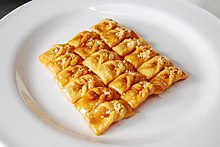|
Maejap-gwa
Maejap-gwa (Korean: 매잡과; Hanja: 梅雜菓), also called maejak-gwa (매작과; 梅雀菓) or tarae-gwa (타래과), is a ribbon-shaped hangwa (traditional Korean confection).[2][3][4] PreparationWheat flour is kneaded with ginger juice and water, then rolled into a flat sheet.[5] The sheet is then cut into small rectangles with three slits in the middle, and the end of each piece is put through the middle slit.[5] The ribbons are then deep-fried, coated in honey or jocheong followed by chopped pine nuts.[5] Gallery
See alsoReferences
|
||||||||||||||||||||||||||||||||||||||||||||||


